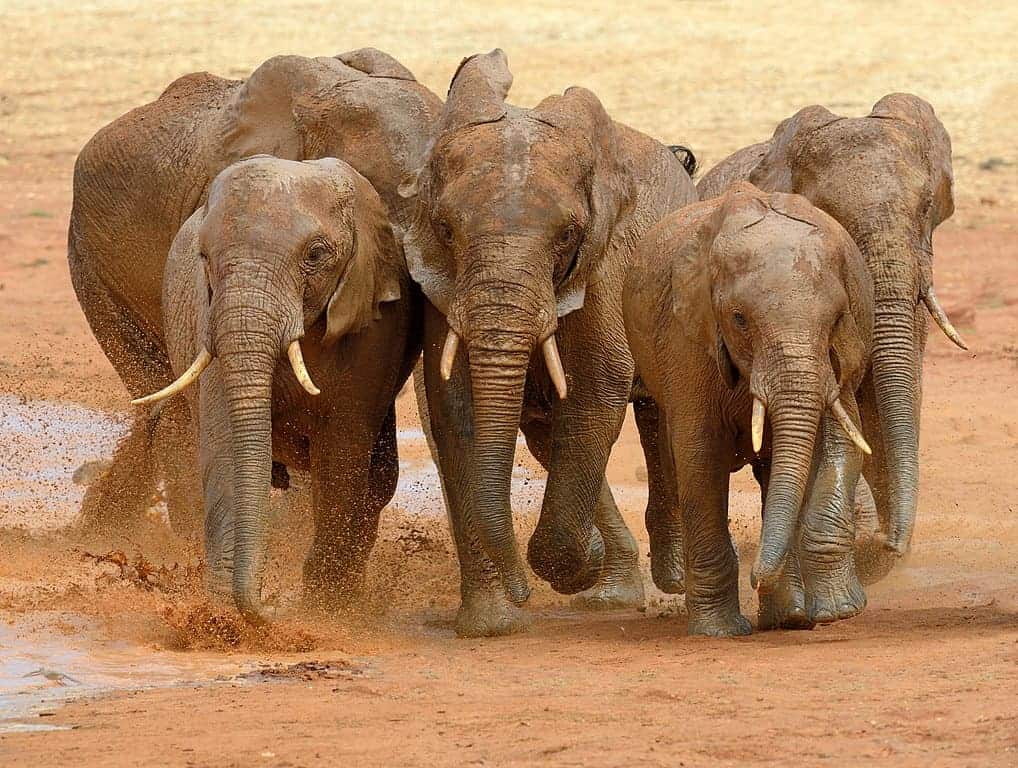Step right into the thrilling world of colossal creatures! Welcome to the Tope 10 Largest Land animals.
Mother Earth has a flair for the dramatic, showcasing an awe-inspiring lineup of beings – from pocket-sized mice to the colossal blue whale, a marine leviathan that’s practically a waterborne skyscraper. While we appreciate the charm of pint-sized critters, today, we’re setting our sights on the land’s heavyweight champions.
Get ready for an exciting journey as we uncover the colossal kings and queens of terra firma. Before we dive into this gigantuan adventure, let’s clarify what we mean by colossal critters. Are we talking about the heftiest, the loftiest, or the lengthiest? This article is your guide to sizing up mammoth marvels, breaking it down by category and dimension. We’ll explore the world’s most gigantic animals by category and reveal the ten bulkiest beasts strutting their stuff on Earth today. It’s about to get big!
Please click below to jump to a section:
Key Points
| Rank | Animal | Description |
|---|---|---|
| 1 | Elephant | African bush elephants, weighing up to 11 tonnes, are the largest land animals. |
| 2 | Giraffe | Adult giraffes are the tallest creatures, with powerful neck muscles and a height of over 5 meters. |
| 3 | Ostrich | Ostriches are the largest living flightless birds, native to large areas of Africa. |
| 4 | Polar Bear | These carnivorous bears reside in the Arctic Circle and play a vital role in polar regions. |
| 5 | Crocodile | The saltwater crocodile is the world’s largest reptile, found in saltwater settings from India to Australia. |
| 6 | Green Anaconda | The green anaconda is the heaviest snake globally, with a maximum length of 5.21 meters. |
| 7 | Capybara | Capybaras are the largest living rodents, often found in groups and known for their social behavior. |
| 8 | White Rhinoceros | White rhinos are one of the world’s largest true grazing animals, preferring smaller foods and grasslands. |
| 9 | Hippopotamus | Hippos are the third-largest land mammals and the heaviest surviving land artiodactyl, residing in water bodies. |
| 10 | Cape Buffalo | African buffalos, both massive and unpredictable, can weigh up to 800 kg and are challenging to capture on foot. |
Introduction to Land Animals
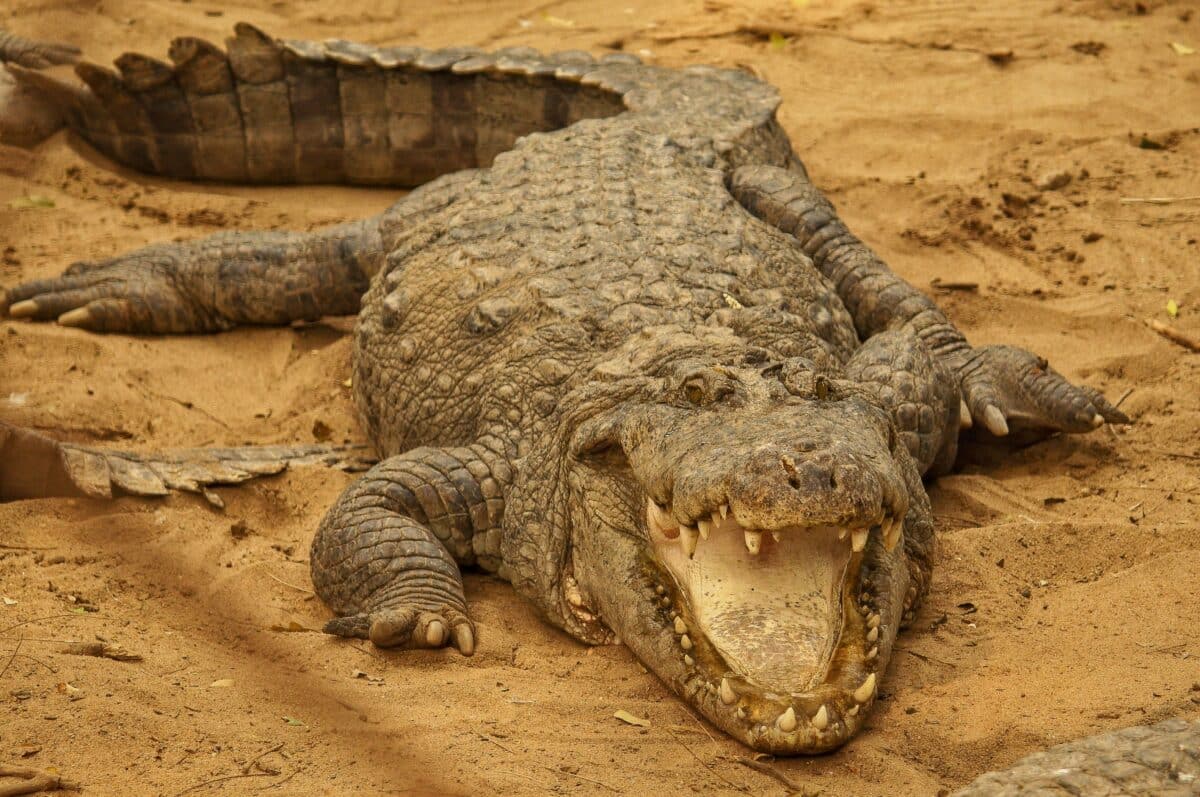
Although man developed cellphones, written language, and french toast, the animal world makes a significant contribution in terms of overall bulk and force. Yes, a human wrote “Romeo and Juliet,” and a man developed the hoover, but these accomplishments mean nothing to a 12-foot-wide crab or a 300-pound bird.
Humans only can bow our necks in admiration of the animal kingdom’s enormous kings and queens. All the animals on this list of top 10 largest land animals share a commonality: they’re all larger than some other animals of their kind. This could be due to a historical trend.
More evidence has developed in recent decades to support Cope’s rule, which asserts that animals develop to become more prominent over generations. So according Stanford research, though not all species have expanded in size over time, those that were already gigantic developed and branched off to become more varied, which can be beneficial in terms of survival.
On the other hand, certain prehistoric species would have been unwelcome visitors in today’s environment due to their immense size. Consider the Titanoboa, a 3,000-pound, 48-foot-long snake whose bones were discovered in Colombia.
Stacker undertook a thorough investigation to construct this one-of-a-kind list, which covers the world’s largest species in each animal kingdom category. These groups, which include mammals, birds, fish, and other animals, present an overview of the living species that stand out among their peers.
#1 Elephant

Mature African bush elephants can reach a length of 24 ft and weigh 11 tonnes. Daily, an elephant must consume roughly 350 pounds of grass. African savanna elephants are another name for African bush elephants. And well deserving of a spot on the top 10 most extensive land animals list.
African bush elephants may be spotted in practically major African countries, but their ecology extends from desert to broad savanna. Elephants in Africa can live for up to 70 years, longer than any other land creature bar humans.
Elephant flocks are highly matriarchal, with the matron, the oldest female in the bunch, managing a number of interrelated females and their progeny. Male adult elephants rarely join flocks and simply remain individually. Occasionally coming into contact with them for the purpose of reproducing.
Females give birth to a healthy calf after a 22-month pregnancy period, the longest amongst animals. An elephant’s trunk is a formidable body, with over 40,000 muscles and tendons capable of simultaneously lifting over 400 pounds.
No wonder they have a spot on the top 10 most extensive land animals list. Read more about the biggest Elephant ever recorded with our Dedicated Article!
#2 Giraffe
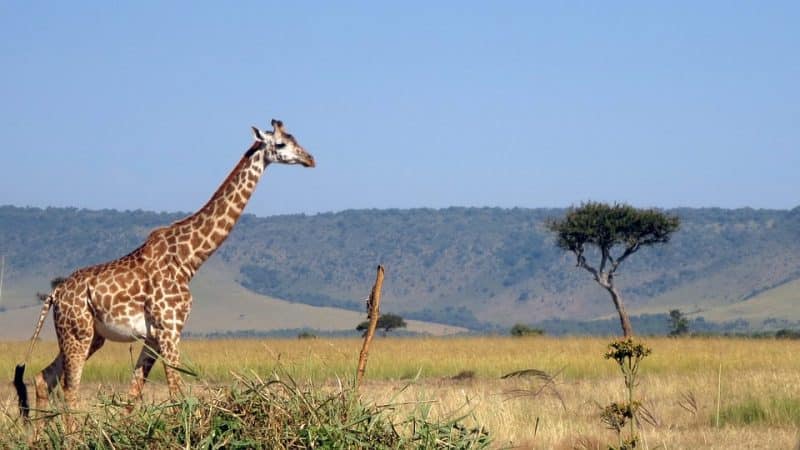
Adult giraffes typically reach a weight of around 1,930 kg, with females typically reaching 1,180 kg. They are easily recognized by their imposing height, adorned with large black tufts at the top and short black hair. Their tails can extend up to a meter in length. Notably, powerful neck muscles are connected to long spines on the upper back’s vertebrae, giving them a distinctive profile that slopes down to their hind legs. These features earn them a rightful place on the list of the top 10 largest land animals.
Giraffes are known to inhabit various locations, often forming groups called “tribes” comprising up to 20 individuals. Their natural range can vary significantly, with some areas as small as 85 square kilometers in humid environments, and others stretching as vast as 1,500 square kilometers in drier regions. Their gregarious nature allows them to maintain a high level of awareness, particularly when confronted by potential threats.
These graceful giants possess excellent vision, enabling them to spot a lion a kilometer away. When one giraffe detects danger, the others tend to follow suit. In the wild, giraffes can live up to 26 years, while those in captivity may have even longer lifespans.
As for their diet, giraffes have a preference for the sensitive young branches and leaves of prickly thorn trees. Their diets resemble that of cows, high in energy and low in fiber. To aid in this selective feeding, their tongues and the insides of their jaws are coated with rough tissue, which helps them grip and pull leaves into their mouths using their opposable lips or tongue.
#3 Ostrich

The common ostrich is the world’s most significant living and flightless bird indigenous to large areas of Africa. That is the only extant belongs to the genus Struthio and the only one of two species of ostriches in the ratite order of birds. BirdLife International designated the Somali ostrich as a distinct species in 2014 after it was previously classed as a subspecies of the ostrich.
The common ostrich belongs to the Struthioniformes order. Struthioniformes included all ratites, including birds, cassowaries, hooved animals, and emus.
Unfortunately, recent genome sequencing has revealed that the group is not monophyletic. But rather paraphyletic with the tinamous, making ostriches the institution’s only members. The common ostrich eats essentially plant matter, but it occasionally eats insects and small reptiles.
It migrates in groups of five to fifty birds. When threatened, the ostrich will either hide or run by lying flat against the ground. Its skin is used to manufacture leather, and its meat is commercially sold, including its lean production being a big seller.
#4 Polar Bear

Polar bears are exclusively found within the Arctic Circle, encompassing the Arctic Ocean, its surrounding waters, and the adjacent land surfaces. These remarkable creatures, though once abundant, are now designated as a threatened species due to habitat destruction brought about by global warming. Throughout the centuries, polar bears have played significant roles in the economic, spiritual, and cultural lives of polar communities, retaining their importance in our societies.
Polar bears are known to roam the Arctic Circle and its adjacent landmasses, with sightings recorded as far south as Newfoundland. Thanks to their remote habitats with limited human development, they’ve managed to preserve much of their native range, making them one of the few carnivores to achieve this.
While polar bears are rare north of 88°, evidence suggests their presence throughout the Arctic region, reaching as far south as James Bay in Canada. Their southernmost range lies at the boundary between subarctic and humid tropical climate regions. Their substantial size also earns them a well-deserved place on the list of the top 10 largest land animals.
Read more about the world’s largest land predator with our dedicated article!
#5 Crocodile

The saltwater crocodile is a variety of crocodiles that can still be spotted from India’s east coast to northern Australia and Micronesia in saltwater settings and brackish wetlands. It has been classed as Least Concern on the IUCN Red List since 1996.
Until the 1970s, it was hunted for its skin across its range, and it is currently threatened by habitat loss and illegal slaughter. Humans are thought to be at risk. The saltwater crocodile is the largest crocodilian and reptile on the planet. Thus scoring itself a place on the top 10 largest land animals list.
Meet the largest Crocdile, Lolong, with our dedicated article!
#6 Green Anaconda
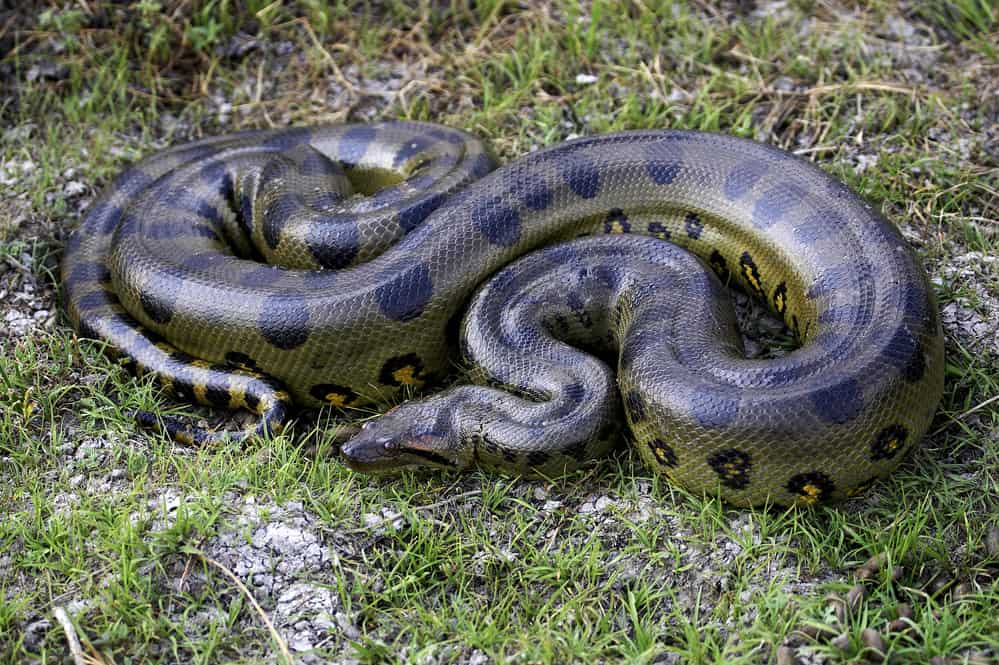
The green anaconda is a South American boa mammal widely recognised as the tremendous anaconda, the widespread anaconda, the public water boa, or even the sucuri. It is also the heaviest and is one of the ancient still-living snake species. Like some other macaws, it is a non-venomous venomous snake.
The term “anaconda” is commonly used to describe this species, but it also can be used to characterise other Eunectes species. With a maximum length of 5.21 meters, the green anaconda is the world’s largest heaviest and one of the world’s longest snakes at 17.1 feet.
The anaconda lives most of its life in or around the water, as it is primarily solitary. They have had the capability to swim at ridiculous speeds. They chose to float with their mouthparts visible underneath the water’s surface.
Once prey flows by or comes to a standstill to drink, the anaconda airstrikes and wraps its body around it without swallowing or devouring it. Giant anacondas, such as tapirs, deer, capybaras, and caimans, are occasionally eaten, but such large meals are rare.
#7 Capybara
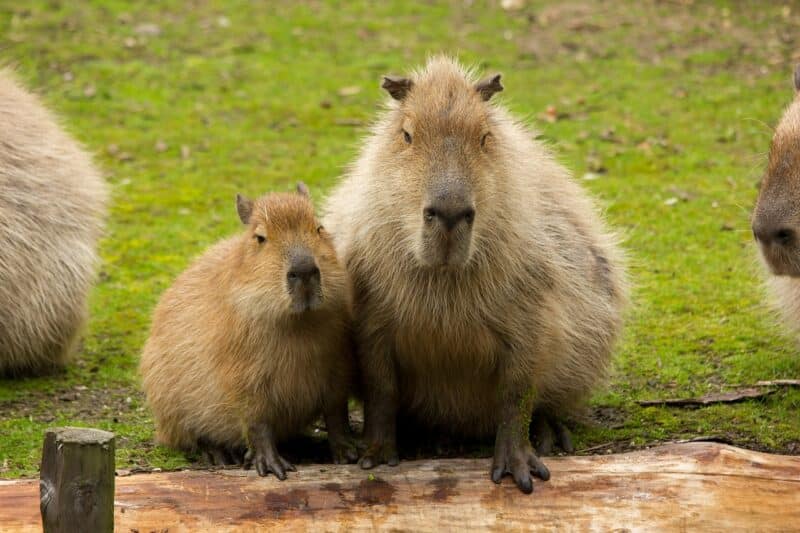
The capybara is a massive South American dwarf hamster rodent. It is the largest global living rodent and belonged to the Hydrochoerus species. Perhaps the only elected member is the tiny capybara (Hydrochoerus isthmus).
Guinea pigs and rocky cavies are close relatives, while nutria, agoutis, and chinchillas belong to more distant cousins. Capybaras inhabit savannas, dense forests, and areas near water sources. They are highly social mammals and can form groups of up to 100 individuals, but they are typically observed in groups of 10 to 20 capybaras.
Capybaras are hunted for their meat, hides, and the oils produced by their thick, greasy skin. Their social behavior is well-documented, with groups usually consisting of 10 to 20 adults, including two to four males, four to seven females, and the remaining juveniles.
Capybara groups can grow to be as large as 50 to 100 members during the dry weather when the animals concentrate around available water sources. Males in social relationships express their dominance and obtain group consensus. They may make dog-like barks when threatened or when females are herding young.
Another great one of the Largest Land Animals.
#8 White Rhinoceros

In 2018, just two females, Fatu, 18, and Najin, 29, were confirmed as enduring northern subgenus members both in captivity. Sudan, the only adult male northern white rhinoceros in the world, ended up dead in Kenya on March 19, 2018.
White rhinos are found in rangeland and grasslands habitats. White rhinos would be among the world’s largest true grazing animals, preferring the tiniest foods. It likes to drink double the daily whether there is freshwater supplied, but it could last 4 or 5 days without having a drink if conditions are dry.
It wants to spend roughly 1/2 of each day choosing to eat, a third of the day falling asleep, and the remaining day having finished other tasks. White rhinos, like other rhinoceros, like trying to cool themselves by indulging in dirt mounds. White rhinos are said to already have developed the framework as well as the environment of either the savanna grass species.
From direct observation of elephants from Africa, researchers consider a white rhinoceros to become a key driver inside its environment. Large animals’ extinction might devastate the ecology and other creatures. White rhinos make a puffing approach cry, moan, and exhale during courting, screeching of fear, and solid booms or growling while attacked.
#9 Hippopotamus

After elephants and rhinoceros, the hippopotamus is the third-largest land mammal and the heaviest surviving land artiodactyl. Despite their morphological similarity to pigs and other terrestrial even-toed ungulates, the Hippopotamidae’s closest living relatives are cetaceans, from whom they split 55 million years ago. Hippos can be found in rivers, lakes, and mangrove swamps, with territorial bulls ruling over herds of five to thirty cows and calves.
They stay cool whilst also spending the entire day in water or sludge, and they replicate and give birth in water. The hippo is among the most dangerous creatures on earth due to its violent and unpredictable nature when provoked. Earning itself a spot on the top 10 largest land animals list.
The modern hippopotamus and the dwarf hippopotamus are the only existing members of the Hippopotamidae family. The Hippopotamidae as well as other sometimes ungulates belong to the Artiodactyla order.
#10 Cape Buffalo

And for its enormity, unpredictable attitude, and proclivity to strike without warning, the African buffalo was added to the Big five list. Upon foot, the African buffalo is amongst the most dangerous animals to capture. Considering that these gigantic bovids weigh 800 kg for males and 750 kg for females, it’s simple to see why.
Buffalo is clearly spotted on a desert safari as they have extremely large bossed horns and evoke a large ox. The male and female buffalo are dimorphic, which means they are highly similar. Adult male buffaloes are often encrusted in mud, and their bosses come with each other in the centre of one‘s head to construct a hard hat structure.
The hairs on the horns of youthful rams are typically still visible. Female buffalo have a reddish-brown colour and relatively narrow horns than male buffalo. Female buffalo have had an 11-month gestation period, and crossbreeding takes place in the late summer.
Summary of the Largest Land Animals
The animal kingdom is teeming with fascinating species of all shapes, sizes, colorrs, and habitats. You’ll discover massive elephants as well as tiny insects, yet they all belong to the same realm. Scientists use a set of specified criteria to categorise their findings.
Because of its giant brain, which is one of the largest in the animal kingdom, this elephant has excellent memory. Elephants can take up both large objects and even a little flower with their trunk! They keep their equilibrium by using their tail. Elephants are divided into two groups: Asian and African elephants.
Elephants are clever and sociable animals. Adult giraffes are the tallest creatures on the planet, while newborn baby giraffes are taller than adult humans of average height. They can consume leaves from lofty trees because of their long neck.
If you enjoyed reading about the Largest Land Animals, check out the top 10 strongest animals in the world and a guide to farm animals next!
Join our Forum for free today!

- These are The 5 Largest Great White Sharks Ever Recorded - July 19, 2024
- The Surprising Benefits of Big Game Hunting - July 18, 2024
- $100k+ Hunting Experiences The Most Expensive Animals to Pursue - July 17, 2024

